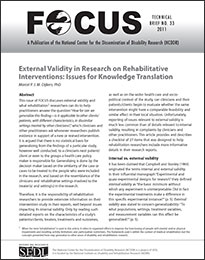FOCUS - Technical Brief Number 33: External Validity in Research on Rehabilitative Interventions: Issues for Knowledge Translation

Author: Marcel P. J. M. Dijkers, PhD
| Price: Available free online |
Available online: Full text, PDF
![]()
This issue of FOCUS discusses external validity and what rehabilitation researchers can do to help practitioners answer the question “How far can we generalize this finding–– is it applicable to other clients/ patients, with different characteristics, in dissimilar settings treated by other clinicians?,” which clinicians and other practitioners ask whenever researchers publish evidence in support of a new or revised intervention. It is argued that there is no statistical basis for generalizing from the findings of a particular study, however well conducted, to a clinician’s next patient/ client or even to the groups a health care policy maker is responsible for. Generalizing is done by the decision maker based on the similarity of the case or cases to be treated to the people who were included in the research, and based on the resemblance of the clinicians and rehabilitative settings involved to the treater(s) and setting(s) in the research.
Therefore, it is the responsibility of rehabilitation researchers to provide extensive information on their intervention study in their reports, well beyond issues impacting its internal validity. Only by reading such detailed reports on the characteristics of a study’s patients/clients, treaters, treatments and outcomes, as well as on the wider health care and sociopolitical context of the study, can clinicians and their patients/clients begin to evaluate whether the same intervention might have a comparable feasibility and similar effect in their local situation. Unfortunately, reporting of issues relevant to external validity is much less common than of details relevant to internal validity, resulting in complaints by clinicians and other practitioners. This article provides and describes a checklist of 27 items that was designed to help rehabilitation researchers include more informative details in their research reports.
